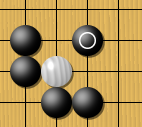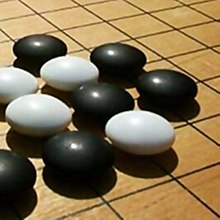
A proverb is a simple and insightful, traditional saying that expresses a perceived truth based on common sense or experience. Proverbs are often metaphorical and use formulaic language. A proverbial phrase or a proverbial expression is a type of a conventional saying similar to proverbs and transmitted by oral tradition. The difference is that a proverb is a fixed expression, while a proverbial phrase permits alterations to fit the grammar of the context. Collectively, they form a genre of folklore.

The game of go has simple rules that can be learned very quickly but, as with chess and similar board games, complex strategies may be employed by experienced players.

Go is an abstract strategy board game for two players in which the aim is to surround more territory than the opponent. The game was invented in China more than 2,500 years ago and is believed to be the oldest board game continuously played to the present day. A 2016 survey by the International Go Federation's 75 member nations found that there are over 46 million people worldwide who know how to play Go and over 20 million current players, the majority of whom live in East Asia.

The rules of Go have seen some variation over time and from place to place. This article discusses those sets of rules broadly similar to the ones currently in use in East Asia. Even among these, there is a degree of variation.

Within most systems and at most levels in the game of Go, a handicap is given to offset the strength difference between players of different ranks.
A Japanese proverb may take the form of:

Life and death (死活) is a fundamental concept in the game of Go, where the status of a distinct group of stones is determined as either being "alive", where they may remain on the board indefinitely, or "dead", where the group will be lost as "captured". The basic idea can be summarized by:

In go and shōgi, a jōseki or jouseki is the studied sequences of moves for which the result is considered balanced for both black and white sides.
A Go game record is an archival record for a game of Go.
The nadare jōseki is one of the most celebrated jōseki in the opening stage game of Go, and the one that has been most deeply studied in modern times. Hundreds of unique variations have appeared in high-level games. Aside from the taisha joseki, which has traditionally been said to have more than 1000 known variations, the avalanche is thought to be the most complex joseki; but the nadare fits much better with current ideas on opening strategy and is often used, while the taisha has been quite unfashionable for a generation as the 5-3 corner opening has gone out of favor.

Wellerisms, named after sayings of Sam Weller in Charles Dickens's novel The Pickwick Papers, make fun of established clichés and proverbs by showing that they are wrong in certain situations, often when taken literally. In this sense, Wellerisms that include proverbs are a type of anti-proverb. Typically a Wellerism consists of three parts: a proverb or saying, a speaker, and an often humorously literal explanation.

An anti-proverb or a perverb is the transformation of a standard proverb for humorous effect. Paremiologist Wolfgang Mieder defines them as "parodied, twisted, or fractured proverbs that reveal humorous or satirical speech play with traditional proverbial wisdom". Anti-proverbs are ancient, Aristophanes having used one in his play Peace, substituting κώẟων "bell" for κύων "bitch, female dog", twisting the standard and familiar "The hasty bitch gives birth to blind" to "The hasty bellfinch gives birth to blind".

A Go opening refers to the initial moves of a game of Go. On the traditional 19×19 board the opening phase of the game usually lasts between 15 and 40 plies. There is some specialised terminology for go openings. The precise meanings of Japanese language terms is often misunderstood.
Paremiology is the collection and study of paroemias (proverbs). It is a subfield of both philology and linguistics.

Professional Go handicaps were a system developed in Japan, in the Edo period, for handicapping professional players of the game of Go against each other. With the abolition of the Oteai system, which from the 1920s had used some handicap games to determine the Go ranking of professional players, this system has become obsolete. It is now completely superseded by the use of komidashi. Knowledge of it is required to understand the conditions of play in historical Go matches, particularly the jubango that died out around 1960.

There are many variations of the simple rules of Go. Some are ancient digressions, while other are modern deviations. They are often side events at tournaments, for example, the U.S. Go Congress holds a "Crazy Go" event every year.
A kofight is a tactical and strategic phase that can arise in the game of go.

In the game of Go, shape describes the positional qualities of a group of stones. Descriptions of shapes in go revolve around how well a group creates or removes life and territory. Good shape can refer to the efficient use of stones in outlining territory, the strength of a group in a prospective fight, or making eye shapes so that a group may live. Bad shapes are inefficient in outlining territory and are heavy. Heavy groups cannot easily make eye shapes and are therefore good targets for attack. Understanding and recognizing the difference between good shape and bad is an essential step in becoming a stronger player.






